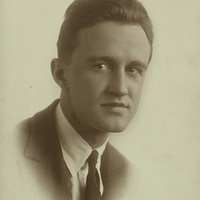This wonderful exhibition of photographs, documents, and publications circulates around the also wonderful figure of Arthur Shields (1896-1970).
Shields was the son of Adolphus Shields, labor organizer, writer for The Freeman’s Journal, and friend of James Connolly and William O’Brien. His mother was of German ancestry, and the parents were by upbringing Protestant—in practice, the family were secular and socialist.
Arthur Shields's oldest brother was Will Shields, best known by his stage-name, ‘Barry Fitzgerald’ (1888-1961).
Shields had three wives, two of whom acted for the Abbey Theatre: Basie McGee, who acted under the name 'Joan Sullavan,' and Una 'Aideen' O'Connor. His third wife Laurie Bailey Shields, an American journalist, was instrumental in collecting additional material for the archive after Arthur's death
His daughter by Aideen O’Connor was Christine Shields. Sara Allgood was her godmother. It was Christine who kept this archive, and ultimately, with other members of the Shields family, gave it—free of charge—to the National University of Ireland in Galway.
When one looks at the spectacular pamphlet of photographs of Sackville (O’Connell) Street before and after Easter 1916, it is helpful to know that Arthur Shields, then just 19 years old, fought with the Citizen Army in the General Post Office, and, having taken refuge in Henry Street, was one of the last rebels to surrender. He was interned thereafter at Frongoch camp, Wales. His military service—by other accounts, marked by bravery under fire—was something about which he never bragged, or hardly, spoke.
The brothers Shields were close friends of Sean O’Casey, and took instrumental roles in the first productions of his ‘Dublin trilogy.’ Arthur Shields was through the 1920s and 30s, the Abbey’s chief ‘handsome lead’; his brother Barry Fitzgerald was the company’s most popular comic actor. Arthur Shields frequently directed plays for the Abbey, and more particularly for George Yeats's 'Dublin Drama Leagure'. In the 1930s, when the Abbey undertook a succession of half-year tours of North America, it was Arthur Shields who handled their management on the road.
These tours won the Abbey a fond welcome in towns and cities across the continent. Broadway producers and Hollywood directors also expressed their interest. John Ford, the great Irish American film director, met with the company in Hollywood, and decided to use some members in The Informer(1935) and all the main players in The Plough and the Stars (1936). Thereafter, Barry Fitzgerald remained in the USA as a film star. Arthur Shields was cast in subsequent movies by Ford. He also was invited to direct plays by Paul Vincent Carroll on Broadway in the late 1930s. By the end of the decade, he and his partner Aideen Shields had left the Abbey for the USA.
The Shields brothers played in well over 100 movies before they returned together to make The Quiet Man, directed by Ford, in County Galway in 1951.
After the death in Dublin of Barry Fitzgerald in 1961, Arthur Shields—suffering from emphysema—spent more and more of his last decade with his stamp collection and his library of Irish and world literature. Joyce and Tolstoy were favorites, but his lodestar was Yeats. Precious volumes from that library are also part of the Shields Family Papers.
Prof. Adrian Frazier, Director of the MA in Drama and Theatre Studies, National University of Ireland Galway
Further Reading:
- Frazier, A."Hollywood and the Abbey," Dublin Review (Summer 2004): 68-86.
- Frazier, A. "Barry Fitzgerald: From Abbey Tours to Hollywood Films," in Irish Theatre on Tour, ed. Nicholas Grene and Chris Morash (Carysfort Press: Dublin, 2005), pp. 89-100.
- Frazier, A. Hollywood Irish: John Ford, Abbey Actors and the Irish Revival in Hollywood, Lilliput Press, Dublin 2011.

